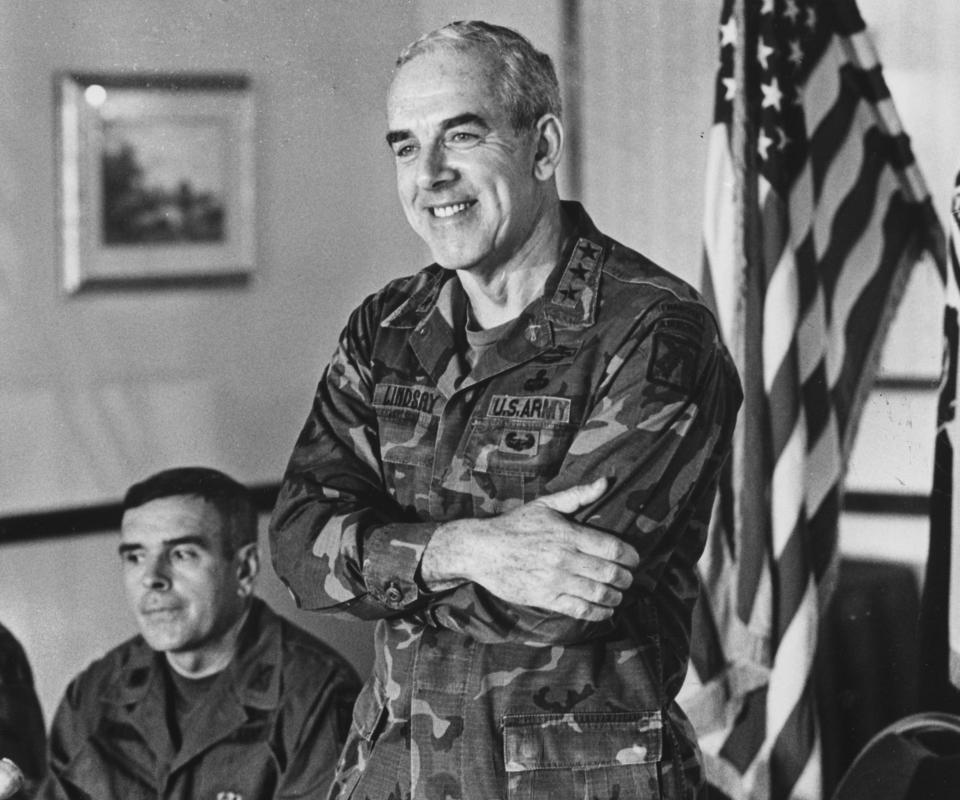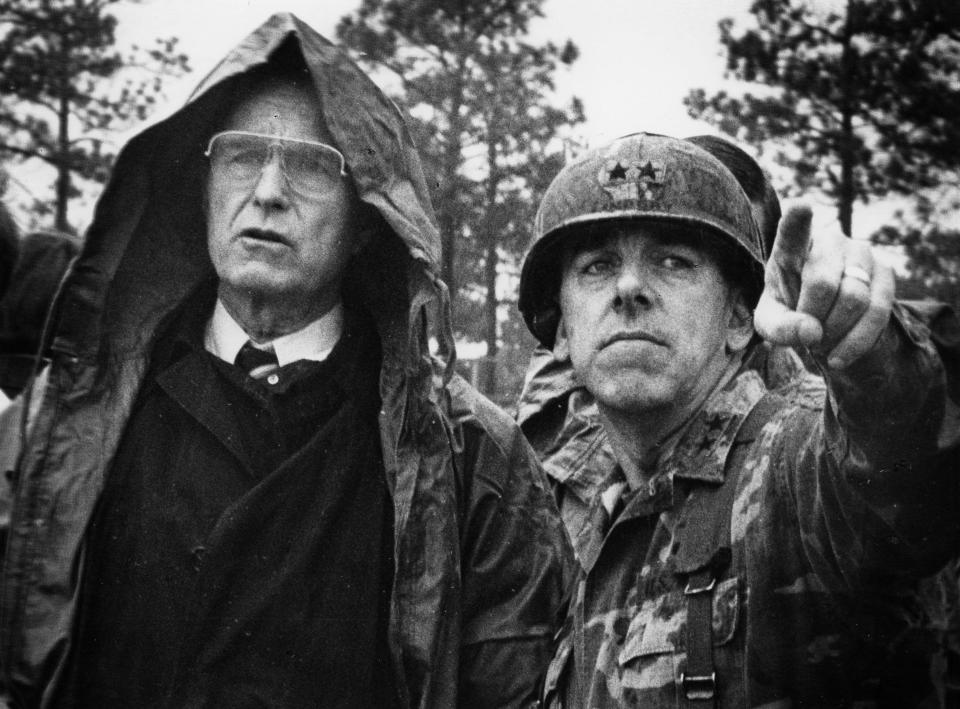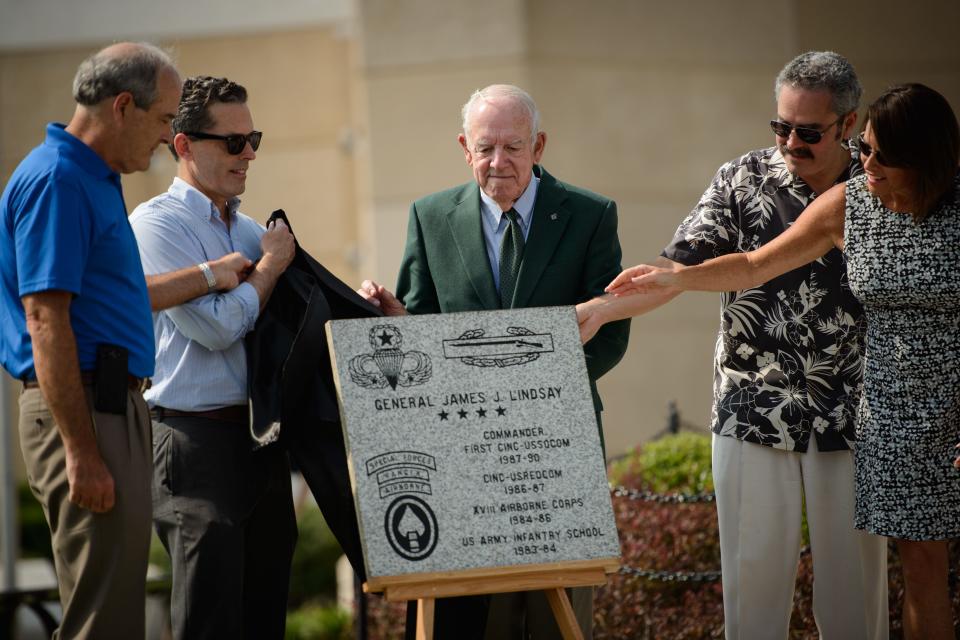'One of our greatest': U.S. Special Operations Command retired Gen. James Lindsay dies at 90
Retired Gen. James Lindsay, whose nearly four decades of distinguished service in the U.S. Army and efforts in his retirement to bring the Special Operations Museum to downtown Fayetteville, transforming the city’s image, has died at the age of 90 in Vass.
The former commander of the U.S. Special Operations Command, 18th Airborne Corps, and the 82nd Airborne Division died of natural causes Saturday night, according to a statement from the 18th Airborne Corps and Fort Liberty.
“Last night, the Airborne and Special Operations Forces communities lost one of its greatest leaders with the passing of Gen. Jim Lindsay. His leadership impacted the fabric of our Nation, and our generation owes him tremendously for his presence and mentorship," Lt. Gen. Chris Donahue, commander of the 18th Airborne Corps and Fort Liberty, said in a statement Sunday. "Gen. Lindsay was truly the heart and soul of what we are all about. We extend our sincerest thoughts and prayers to Gen. Lindsay’s family as we all grieve this loss."

From Wisconsin farmland to a four-star general
A native of Portage, Wisconsin, Lindsay served in the U.S. Army for 38 years, first enlisting in February 1952 as a buck private. After attending Officer Candidate School at Fort Benning, Georgia, he was commissioned as an infantry officer in 1953. His initial assignment was as a platoon leader in the 325th Airborne Infantry Regiment, 82nd Airborne Division.
When asked why he joined the military, Lindsay told the News and Observer in 1986, “I was going to the University of Wisconsin and I ran out of money. So I thought I would go into the Army and come back on the GI Bill. And 34 years later, I'm still here.”
Following his first stint with the 82nd Airborne Division, Lindsay would go on to serve at then-Fort Bragg with the since-deactivated 77th Special Forces Group at the Fort Bragg Noncommissioned Officer Academy and in numerous roles within the 82nd Airborne Division.
During his time in North Carolina, he found his bride; marrying Geraldine C. Parker of Fairmont in a ceremony April 2, 1953, at the main post chapel on Fort Bragg. The couple had four children.

Creation of the U.S. Special Operations Command
In 1988, Lindsay was nominated by President Ronald Reagan as the first commander of the then-newly created U.S. Special Operations Command at MacDill Air Force Base near Tampa, Florida. He was confirmed by the Senate without debate, according to the command’s official history.
In his hometown newspaper, The Capital Times, Lindsay was described in a story about his nomination as exuding confidence, "all spit-and-polish in his bearing and appearance: tall, silver-haired, impeccably uniformed, down to his shiny combat boots that cover an ankle he broke two months ago while parachuting with his troops at Fort Bragg."
In 1988, an Associated Press article on his nomination described Lindsay as a "cigar-chomping" general "who speaks Russian and German and at age 55, wins medals in the triathlon and has run 10 marathons." In his role as commander of USSOCOM, Lindsay was in charge of “forging elite units of the Army, Air Force and Navy into a cohesive force."
Among his other military appointments, Lindsay commanded the 18th Airborne Corps, U.S. Army Infantry School, 82nd Airborne Division, U.S. Army Readiness Command, the 3rd Brigade Combat Team, 82nd Airborne Division, the 2nd Battalion, 60th Infantry, 9th Infantry Division, and Company B, 1st Airborne Battle Group, 503rd Infantry Regiment.

Awards and accolades
By the time he retired in 1990, Lindsay had amassed an impressive list of military accomplishments including four Bronze Stars, four Silver Stars, two Distinguished Service Medals and the Distinguished Service Cross.
In the citation for the Distinguished Service Cross, he was heralded for extraordinary heroism in Vietnam while serving with Headquarters Company, 2nd Battalion, 60th Infantry, 1st Brigade, 9th Infantry Division. The citation called then-Lt. Col. Lindsay's actions "exceptionally valorous" during an operation from May 31 to June 4 1968 that located and destroyed three main Viet Cong and North Vietnamese battalions in the Plain of Reeds.
On those dates, after two days of tracking the enemy, Lindsay and his soldiers were inserted by air into the flank of the communists.
"Immediately upon landing, his men were brought under extremely heavy automatic weapons and small arms fire from a nearby woodline. Moving from position to position under the hail of bullets, he directed his troops' fire and, once fire superiority had been gained, led an assault into the hostile bunker complex which destroyed sixty of the fortifications and forced the enemy to withdraw," the citation reads.
Lindsay then directed the encirclement of the foe from a helicopter, including stopping escaping Viet Cong with hand grenades and rifle fire.
"After returning to the ground, he exposed himself to the vicious enemy fusillade to coordinate return fire which repelled the enemy's attempt to break the encirclement. While leading a sweep through the woodline early in the morning of 4 June, he surprised three Viet Cong whom he engaged and killed before they could inflict any casualties upon his men," according to the citation.
Beyond his military accolades, Lindsay worked for at least a decade after his retirement to preserve the legacy and artifacts of the Army's airborne and special operations forces including the creation of the Airborne & Special Operations Museum in downtown Fayetteville.
For his work on the museum, which opened in 2000, he was honored in 2018 as the first recipient of Fayetteville's Hometown Hero Award for leading the effort to build the museum, transforming the razed block with a seedy history that once was Hay Street. He is also credited with bridging the divide between Fort Bragg and Fayetteville’s civilian population.
“It is with a heavy heart we say goodbye to Gen. James Lindsay. As a former senior leader in the Airborne community, Gen. Lindsay embodied everything it means to be Paratrooper, a leader, and most importantly a good and decent human being," Maj. Gen. Christopher LaNeve, Commander of the 82nd Airborne Division said in the statement. "With more than 38 years of service to his country, commanding and leading Soldiers at every echelon, he left an amazing legacy for us to emulate in the 82nd Airborne Division and he will truly be missed. Our thoughts and sympathies are with the Lindsay family and friends as they mourn the loss of this great American."
F.T. Norton can be reached at fnorton@fayobserver.com.
This article originally appeared on The Fayetteville Observer: Gen. Lindsay, former leader of airborne and special operations, dies at 90

